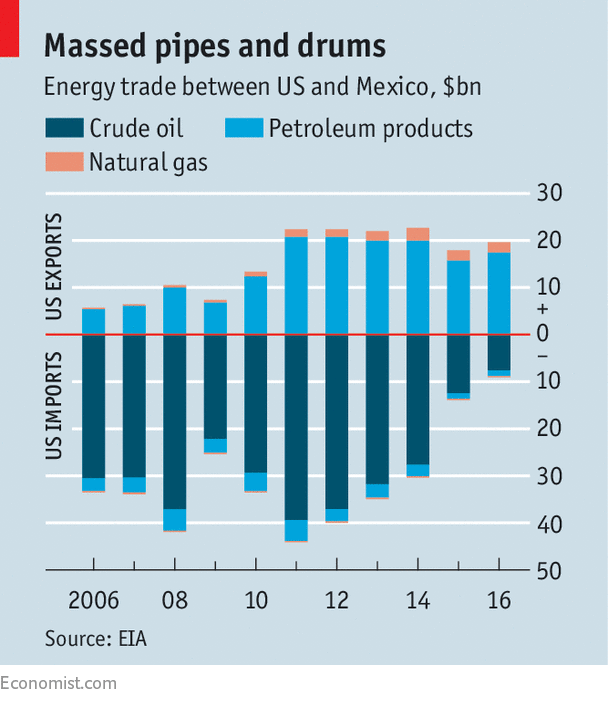
“A CHEMICAL engineer at Pemex, Mexico’s state-owned oil company, opens a tap atop a maritime platform in this offshore oilfield in the southern part of the Gulf of Mexico. She decants a jar of heavy Mexican crude that comes, hot to the touch, from 3,500 metres below the seabed. It looks like a succulent chocolate sauce, but smells like the back end of a cow. “Taste it,” she laughs.”
“The crude that she is testing is pumped a short distance across the sea to a vast floating storage tank, known as an FPSO, where it is blended with lighter crude for export. The FPSO stores about 2m barrels—roughly the equivalent of a day’s worth of Mexican oil production. A quarter of that is fed into a supertanker tied alongside, contracted by Chevron, America’s second-largest oil firm. It then sails north across the maritime border to Texas or Louisiana where the crude runs through refineries. The refined petrol or diesel often then returns to Mexico.”

“This about-turn has been caused by several factors, namely America’s shale boom, Mexico’s slumping oil output (down by more than 1m barrels a day in a decade) and energy liberalisation in 2014 that ended Pemex’s 75-year-old hegemony over the domestic oil industry. This shifting landscape has already had an effect on Pemex: a recent bump in oil prices, combined with cost-cutting, has led to its first consecutive quarterly profit in six years. The ripple effect through North America’s energy business has also been quick, and should expand—provided it is not derailed by a hamfisted effort to renegotiate NAFTA.”
“The cross-border flow of hydrocarbons is the most tangible change. Petrol from American refineries amounts to about half of Mexico’s domestic consumption. Last month Tesoro, a Texan refiner, became the first private firm to win an auction to move imported petroleum products through Pemex’s own tanks and pipelines.”
“Mexico has also become the destination of choice for surplus American natural gas, produced in the shale revolution. Sales south of the border have almost doubled since 2014, as Mexico switches its power generation from coal and oil to cheaper, cleaner fuels. The capacity of natural-gas pipelines crossing the border is expected almost to double over the next three years. Since Cheniere Energy became the first firm to export American liquefied natural gas last year, much has flowed to Mexico.”
“Investment is also flowing. American oil companies won five out of the eight blocks auctioned in Mexico’s first sale of deepwater oil licences last year. That forms part of what Pedro Joaquín Coldwell, Mexico’s energy secretary, says are $49bn-worth of international investment commitments in exploration and drilling since 2015. José Antonio González Anaya, Pemex’s boss, says he hopes to encourage American refiners such as Tesoro and Valero to co-invest in some of Mexico’s six refineries. But all were built before 1980, are decrepit, and lose about $9bn a year.”
“The changes are becoming visible at the petrol pump. ExxonMobil, America’s largest oil company, announced in May that it would open its first petrol station in Mexico this year and invest $300m in fuel distribution over the next decade. Currently, only one petrol station in Mexico is owned by a supermajor, BP (its enthusiastic pump attendants work for salaries, not tips, unlike those at Pemex-branded ones).”
“At a congressional hearing in Washington this month, experts noted that the United States, Mexico and Canada are on track to achieve North American energy independence by 2020—meaning the region will produce more liquid fuels than it consumes. Cheap, abundant energy will boost the region’s industrial competitiveness; it will also reduce its dependence on less stable producers such as Venezuela and Persian Gulf States.”
“But in both America and Mexico, uncertainties loom. The process under way to renegotiate NAFTA could jeopardise energy co-operation if Mr Trump pulls America out of the treaty, as he has threatened to do. Since Mexico’s energy liberalisation, NAFTA’s provisions have helped provide certainty to foreign investors. Those safeguards could be valuable if Andrés Manuel López Obrador, a staunch opponent of energy reform, wins Mexico’s presidential election next year. He could take issue with the growing dependence on American fuel. A vibrant network of North American energy markets is taking shape, but it remains fragile—especially with populists blundering about in positions of power.”

Scroll to top



